
Did you know that Ferrara was in the Renaissance one of the major cultural centers in Europe? Its rulers, the powerful Este, were patrons of the arts and welcomed to their court some of the leading artists and intellectuals of the time, including Piero della Francesca, Titian, Leon Battista Alberti, Ariosto, Michelangelo, just to name the most famous. (Ferrara-born Cosmè Tura, Francesco del Cossa and Biagio Rossetti may not be as well known, but they were seminal in the history of the art and architecture of the city and you’ll find their legacy everywhere.)
The intense cultural activity of Renaissance Ferrara is reflected in the palaces, churches and works of art that still grace this city 45 minutes north-east of Bologna, a day trip I’d recommend.
Much of the architecture and art you see today is related to the Este, who became lords of Ferrara in 1264 and remained in power there until 1598, when the city was incorporated into the Papal States.
Ferrara is also a Unesco World Heritage site, cited as “an exceptional example of Renaissance period urban planning,” which would later influence the urban design of other Italian and European cities. The prime instance of this is the so-called ‘Erculean Addition,’ an expansion of the city in the late 15th century which, for its innovative traits and rational plan, made Ferrara the first modern city in Europe.
Given these premises, I’m not sure why Ferrara doesn’t get the attention it deserves. But if I’ve piqued your curiosity, read on for the best things to see on a day trip to Ferrara.

What to See in Ferrara on a Day Trip from Bologna
The center of Ferrara is small and compact and can easily be explored on foot, or, if you want to do it the Ferrarese way, on a bike (Ferrara is famous for being very bike-friendly).
- Cathedral
Since the Middle Ages, the area around the Cathedral has been the hub of city life, the place where the Ferraresi still like to gather, and the ideal starting point of a day tour in Ferrara.
The Cathedral was inaugurated in 1135; its façade is a beautiful blend of Romanesque and Gothic elements. Above the central loggia is a magnificent Giudizio Universale (Last Judgment), carved in marble.
The interior is monumental, with a complex decoration of paintings and sculptures.
The unfinished bell tower, in white and pink marble, is an elegant example of Renaissance architecture, whose design is attributed to renowned Renaissance architect Leon Battista Alberti.
By the right flank of the Cathedral is the Loggia dei Merciai, a portico built in the 15th century: modern-day stores have replaced artisans’ small shops, but its function of accommodating merchants has remained the same since then.
- Piazza Trento e Trieste
The Loggia dei Merciai faces Piazza Trento e Trieste, which was once called ‘Piazza delle Erbe’ (Herbs Square). Built at the same time as the Cathedral, it was for centuries the site of the main city market. The seats of religious and civil power were built around it. Today, this pleasant pedestrianized area hosts an antiques market every first weekend of the month, a weekly market on Fridays, a Christmas market during the holidays, and occasional themed markets throughout the year.
- Palazzo Municipale
In front of the Cathedral, the former Ducal Palace was the residence of the Este, the powerful family that ruled Ferrara for roughly three centuries and made Ferrara the capital of their Duchy. The statues to the side of the ancient access to the palace (called Volto del Cavallo) are those of Borso d’Este, the first Duke of Ferrara, sitting on the throne, and of the Marquis Niccolo III d’Este on a horse (this guy had his second wife beheaded because she was guilty of adultery – more on that later).

Through the Volto del Cavallo, you access the courtyard once overlooked by ducal apartments. Here you can admire a monumental staircase, which leads to the Camerino delle Duchesse, a beautifully decorated small space built for noblewomen Eleonora and Lucrezia d’Este.
- Estense Castle
The monument symbol of Ferrara, the Estense Castle (originally called Castello di San Michele) was erected as a fortress in 1385 after citizens revolted against the Este to protest the high taxes. It was only in the 15th century that the castle became the residence of the Este, thus it was embellished, and the rooms adorned with frescoes, marbles, friezes and grotesque decorations.
Looking at it from the outside, its massive stance, the moat, the drawbridges, and the towers all testify to its original defensive function.
I suggest you book the guided tour, which lasts about an hour and will bring to life the several spaces open to the public, giving you a glimpse into courtly life.
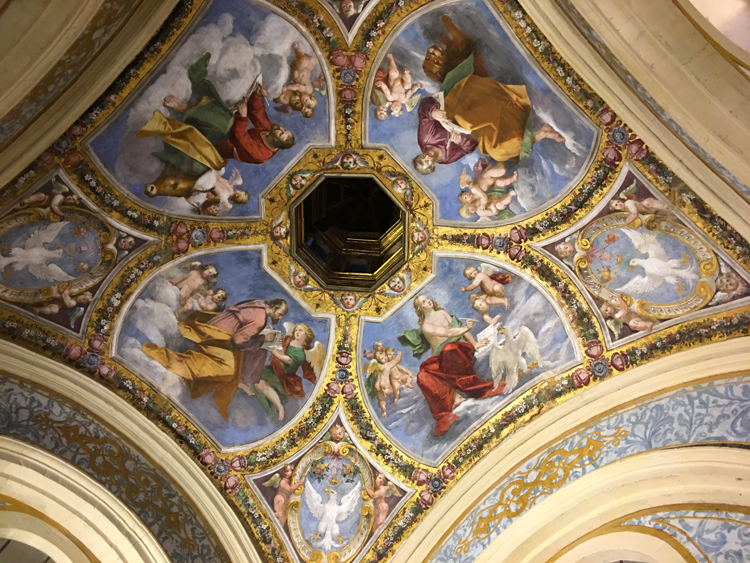
I was especially impressed by the dark, cramped spaces of the prisons, where Parisina Malatesta, the second wife of Niccolò III d’Este, was imprisoned with her lover, Ugo dei Tolomei, one of the many children of Niccolò (so technically Parisina’s stepson). Parisina was only 14 years old when she was married to 35-year-old Niccolò and ended up falling in love with Ugo, but Niccolò found out and, before beheading both of them, he had them imprisoned in what are now known as the Prigioni di Ugo e Parisina.
I also very much enjoyed the Salone dei Giochi, which I would translate as the Sports’ Room, because the ceiling is frescoed with depictions of various sports scenes (it was a grand room used to welcome and entertain guests), and the open-air Giardino degli Aranci (Oranges’ Garden), where the ladies gathered to gossip.
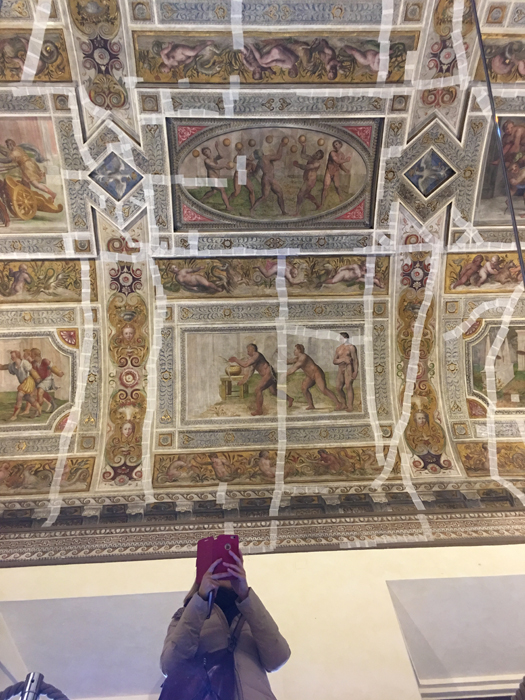
Finally, don’t miss the climb up to the Torre dei Leoni (Lions’ Tower) for a panoramic view over the historic center of Ferrara and the Po Plain in the distance. This is also a great vantage point to admire the Erculean Addition.


*If you’ve seen the sights in the order listed in the article, it may now be time for lunch. You could stop in the pleasant cafeteria of the castle, located on the piano nobile in a frescoed room, with city views and the chance to try typical local dishes (scroll to the end of the article for a list of what you should try).
- Addizione Erculea (Erculean Addition)
Once you’ve finished visiting the castle, head north along Corso Ercole I d’Este to walk along the part of town that gave Ferrara its Unesco status, the Addizione Erculea. Commissioned by Ercole I d’Este, Duke of Ferrara (hence its name) to the brilliant architect of the Este court Biagio Rossetti, it is, as described by Unesco, “one of the first urban plans based on the idea of perspective – that is, balancing humanist principles relating to form and volume in architecture with open space, the needs of the city, and local traditions.”
Corso Ercole I d’Este is flanked by noble palaces, including the famous Palazzo dei Diamanti: its exterior walls are covered with 8,500 diamond-shaped stones (diamonds were one of the emblems of the Este). On the ground floor is an exhibition space often hosting high quality exhibitions, while on the first floor is the Pinacoteca Nazionale, an art gallery displaying works of art by Ferrara artists from the 13th to the 19th centuries.
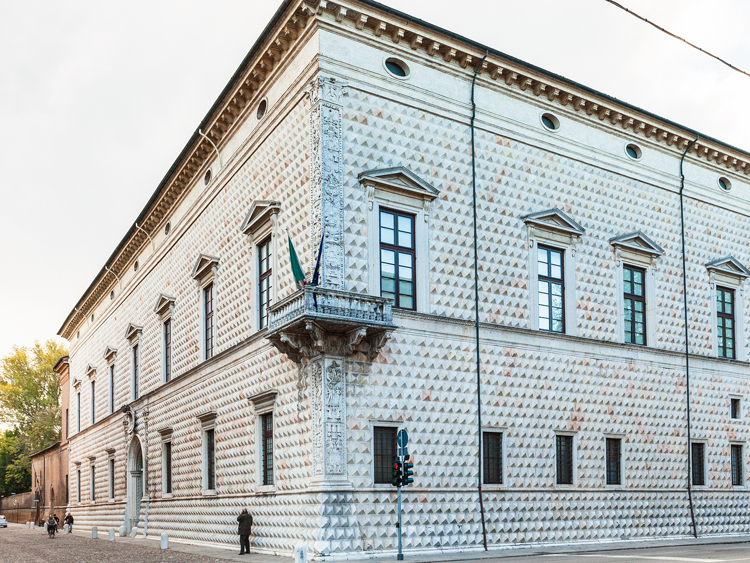
- Via delle Volte
You cannot leave Ferrara without having taken a stroll along its medieval section, and especially Via delle Volte, the long and narrow street which was once the commercial hub of the city. Its elevated passageways are thought to have connected the merchants’ houses with their warehouses on the banks of the river Po, which once flowed nearby; according to another interpretation, the vaults were used to recover habitable spaces in a densely populated area.
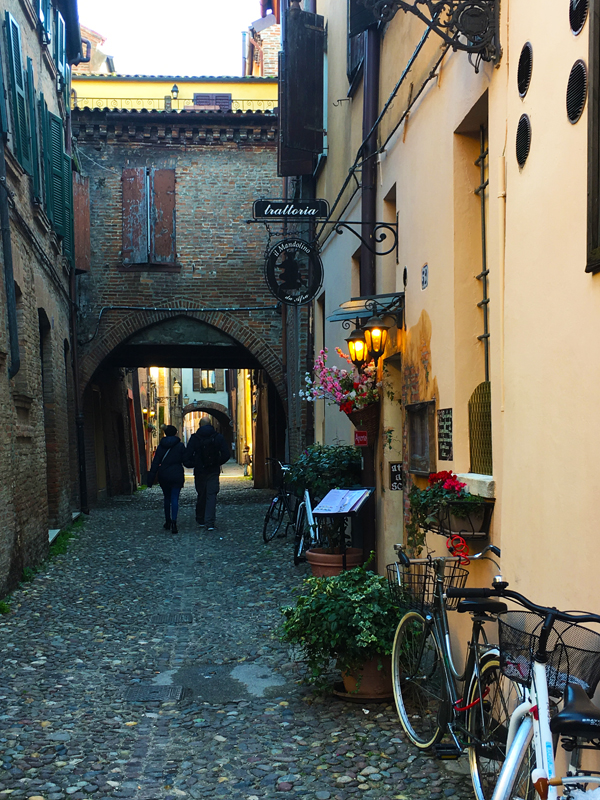
What to See in Ferrara on a Longer Stay
You won’t probably have time to see much else on a day trip from Bologna to Ferrara, but I want to mention a few other sights to keep in mind, should you want to take a second day trip from Bologna or perhaps spend two days in Ferrara.
- Palazzo Schifanoia
This palace built in 1385 was the leisure palace of the Este, as its name implies – schifanoia, or schifare la noia, keep boredom away (don’t you love this?!). This palace guards one the most precious artistic treasures of Ferrara, the frescoes of the Salone dei Mesi, painted between 1469 and 1470 by Francesco del Cossa, Ercole de’ Roberti and other painters of the ‘Officina Ferrarese’, local painters at the court of the Este. The cycle was commissioned by Borso d’Este to celebrate his government activity and lets you see in great detail the fashion and architecture of the time.
- Palazzina Marfisa d’Este
This is a magnificent example of a noble residence from the 16th century, once surrounded by splendid gardens. Built by Francesco d’Este, it was inherited by his daughter Marfisa, who lived in the palace until her death, refusing to leave it even after the Este moved to Modena when the city went under the rule of the Pope at the end of the 16th century.
- Jewish Ghetto
Jewish presence in the city dates from the 13th century and, under the Este, Jews expelled from other countries were welcomed in Ferrara. The Ghetto was established in 1627 by the papal government, which ended the Este’s liberal approach. The main streets of the ghetto are Via Vignatagliata, Via Vittoria, and Via Mazzini (now a main shopping street). At no. 95 on Via Mazzini are the synagogue and the Museo Ebraico (Jewish Museum).
- The Walls
Ferrara is still encircled by nine of the original 13 kilometers of walls and you can walk all along them to admire what is considered a prime example of military architecture, studied even by Michelangelo. Built in different time periods, they are among the most important in Europe. They also represent a chance to enjoy a bit of greenery in the city.
How to get to Ferrara
By train: from Bologna, the fast regional train (regionale veloce) takes 30 minutes and costs €4,75 each way. From Ferrara train station, it’s a 20-minute walk to the Cathedral.
By car: Autostrada A13 Bologna-Padova, exit Ferrara – it’s a 45-minute drive and there’s a convenient parking area just outside the city center (only free on Sundays).
What to eat in Ferrara
Cappellacci di zucca ferraresi – pumpkin-filled handmade pasta, the dish symbol of Ferrara enjoyed since the Renaissance.
Salama da sugo – another dish from the Renaissance, the salamina, as it’s affectionately called, is a cured meat made from pork mixed with spices and red wine. Only for meat lovers!
Coppia ferrarese – the typical Ferrara bread shaped like an X.
Tenerina – rich, dark chocolate cake, perfect to end your meal!

*Love Emilia-Romagna food? See these ten culinary treats you should try.
If you liked this post, please share it via the buttons below!

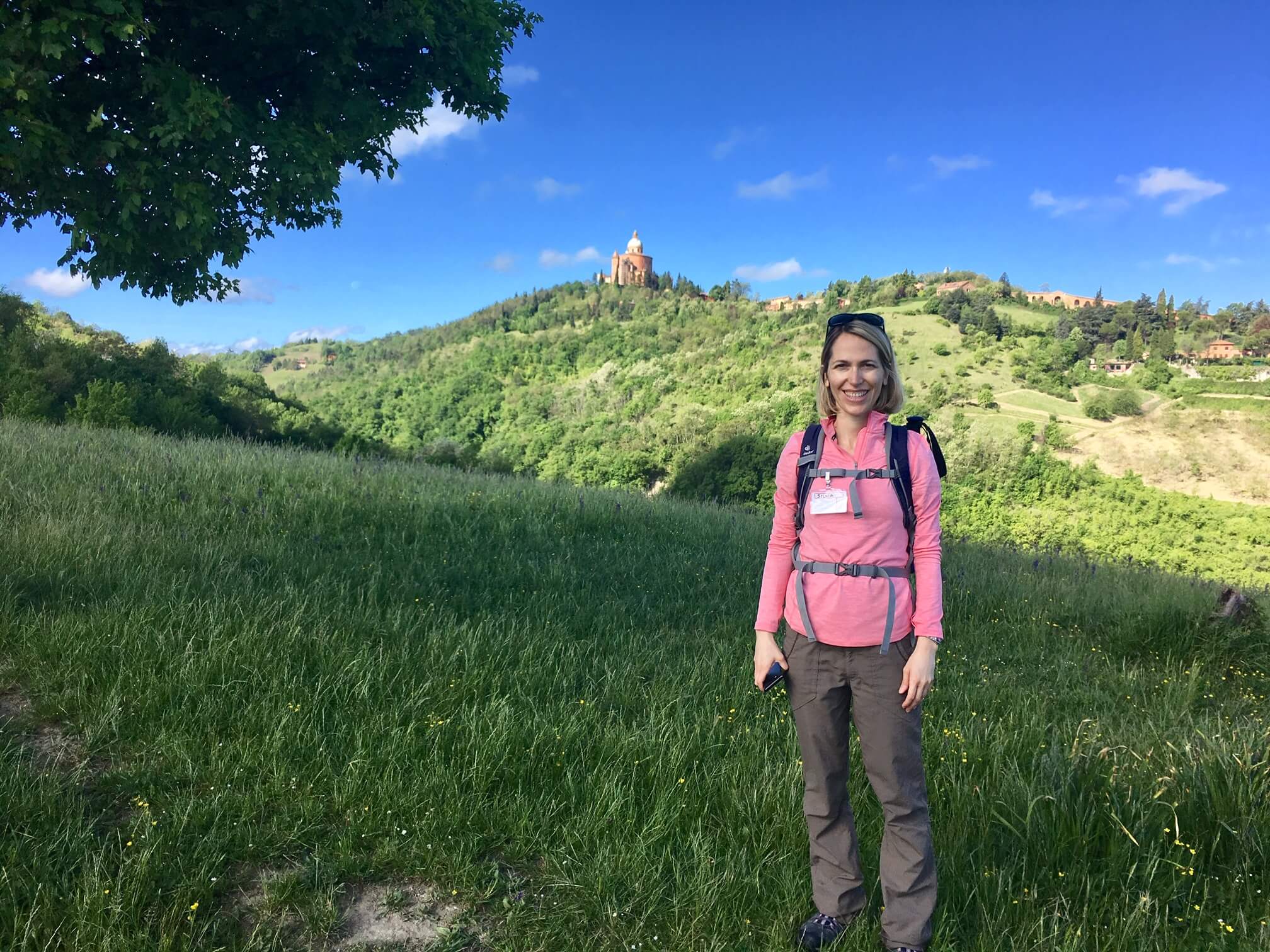
Thank you so much for this one. Your posts are absolutely wonderful to a Texas traveler who has spent more than 45 years traveling and living in your magical country at every opportunity! Yes, I’m a Texan but my heart lives in Italy.
Thank you, Ina, for your very nice comment, it makes me so pleased that you enjoy my posts! Happy to hear you love Italy so much. I think for me it’s a little the other way around, I’m Italian, but my heart lives in California!! 😉
Hi Silvia,
Thank you for sharing the photos and information about Bologna. I make my own shoes and enjoy learning and reading about Italy since so many great shoemakers are from Italy.
Have a wonderful day!
Rob
Thank you, Rob, and congratulations on making your own shoes!
After these photos i was thinking to go in Ferrara only to eat cappellaci di zucca….
Honestly, I think it would be worth it even just for that 😉
Hi Silvia,
My wife and I will be returning to Bologna in the fall. Hopefully you will be doing some hiking tours during October, November time frame.
We enjoy your Wonderful post and pictures. Ferrara is another fascinating city, I enjoyed a morning bike tour in Ferrara, but I’m ready to go back for a longer visit.
Tony
Hi Tony, thank you for your kind message! So glad you enjoy my posts and pictures, and yes, I plan to be running tours in October/November, so let’s be in touch! I’ll post info on my tours on the site as I create them, but you can also write me for additional details/interests you may have. A presto!